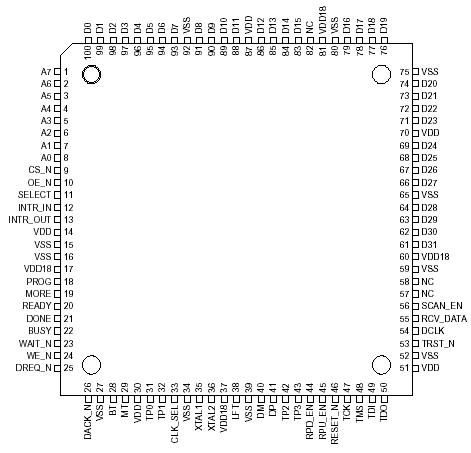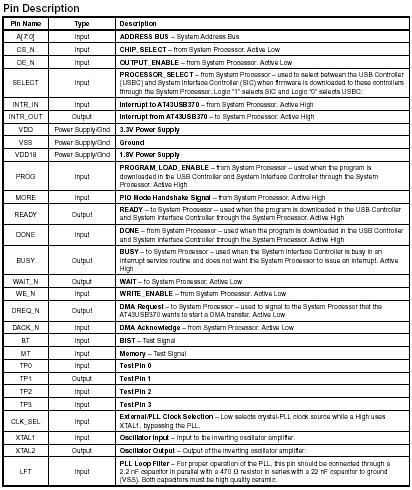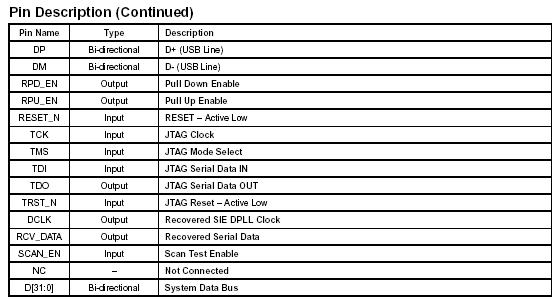Features: • USB 2.0 Full Speed Host/Function Processor
Real-time Host/Function Switching Capability
Internal USB and System Interface Controllers
32-bit Generic System Processor Interface with DMA
Separate TX and RX Buffers for Host and Function Operations
In-System Firmware Upgrade
• Autonomous USB Host Operation without System Processor Intervention
Device Enumeration
USB Protocol Management
Bus Bandwidth Reclamation
Status Handling
Control, Bulk, Interrupt and Isochronous Transfers
Supports Up to 7 USB Devices Concurrently
• Full-speed Function Controller
1 Bi-directional Control Endpoint
6 Programmable (Maximum Packet Size and Endpoint Type) Endpoints
Control, Interrupt, Bulk and Isochronous Transfer Support
Automatic Retry for Non-Isochronous Endpoints
• Integrated USB Firmware
Easy-to-use, ANSI C Compliant API USB Device Driver Development
Embedded, OS Agnostic USB Host Stack
Embedded System Interface Controller Driver
Embedded USB Hub Driver
• 6 MHz Operation
• 1.8 V and 3.3 V Operation
• 100-pin LQFP Package
Pinout

 Specifications
Specifications
|
Symbol |
Parameter |
Condition |
Min |
Max |
Unit |
|
VCC |
3.3V Power Supply |
-- |
3.0 |
3.6 |
V |
|
VIN (3.8V) |
DC Input Voltage |
-- |
VCC -0.3V |
VCC +0.3V |
V |
|
VIN (1.8V) |
DC Input Voltage |
-- |
1.65 |
1.95 |
V |
|
TORP |
Operating Temperature |
--) |
0 |
70 |
|
|
TSTG |
Storage Temperature |
-- |
-40 |
125 |
|
DescriptionAtmel's AT43USB370 is a USB 2.0 compliant, dual-role, full-speed Host/Function processor designed specifically to enable point-to-point USB connectivity for embedded devices. AT43USB370 features an integrated USB host stack, a system interface driver, on-chip USB signaling hardware, 32-bit generic system processor interface with DMA support, and on-the-fly host/function switching capability.
The on-chip USB hardware features of AT43USB370 a USB transceiver,a serial interface engine (SIE), a SIE controller, and an SOF generation block.It supports the physical and data link layer of the USB protocol whereas the USB transaction layer is implemented in firmware.
In host mode, the integrated USB firmware consists of the Host USB Controller Driver (HUSBCD) running on the USB Controller (USBC) and the Host System Interface Controller Driver (HSICD) resident on the System Interface Con-troller (SIC). The HUSBCD AT43USB370 provides complete USB protocol management including device enumeration, transaction management, scheduling and frame management, and bus reclamation. The HSICD serves as an interface between the HUSBCD AT43USB370 and applications resident on the external system processor. It handles all of the high-level data flow management during a USB transaction. Together, the HUSBCD and the HSICD deliver complete USB host operations autonomously, without the intervention of the system processor.
The AT43USB370 communicates with the external system processor through its generic 32-bit host processor interface. This system interface contains 2 Kbytes of FIFO and a DMA engine designed to ensure maximum bus utilization. The automatic USB retry mechanism minimizes data traffic across the system interface.
As a function, the AT43USB370 operates in full-speed mode. AT43USB370 supports one control endpoint and a maximum of six programmable (maximum packet size and endpoint type) endpoints. The internal USB controller runs the function firmware that manages USB enumeration and data flow control without system processor intervention.
Communication between the AT43USB370 firmware and applications resident in the system processor is realized through a small set of ANSI C compliant, system interface Application Protocol Interfaces (APIs). This API set encapsulates the complete USB functionality. It is used as the basic building blocks for constructing application specific USB device drivers of any type.
The AT43USB370, with its highly integrated USB hardware/firmware architecture, not only hides the complexity of the traditional USB design, but also frees system resources from being burdened by timing critical USB activities. AT43USB370 is an ideal solution for point-to-point USB connectivity in the resource constrained embedded environment.

 AT43USB370 Data Sheet
AT43USB370 Data Sheet











